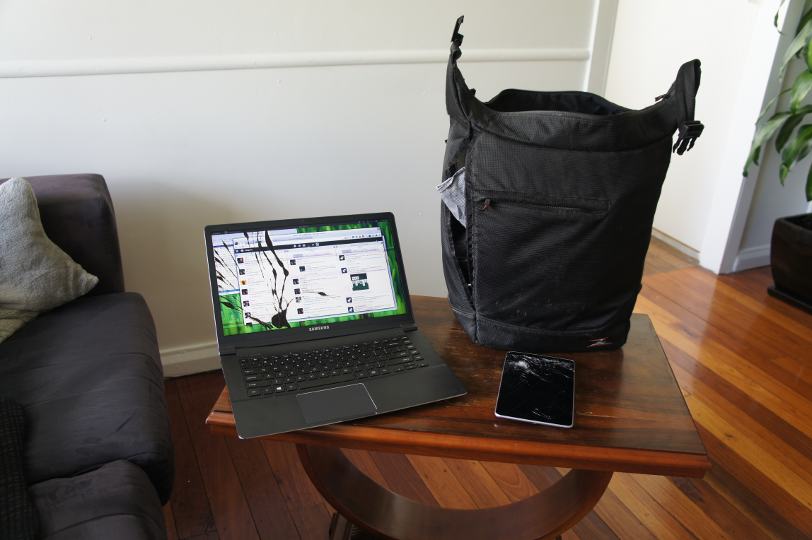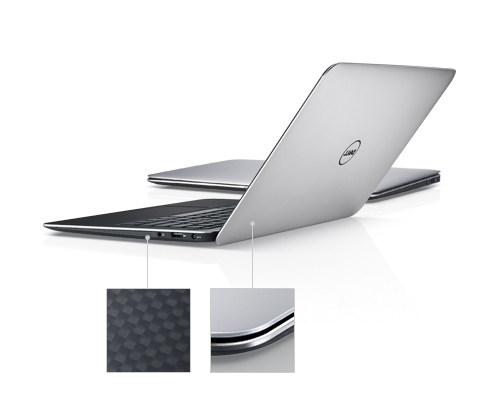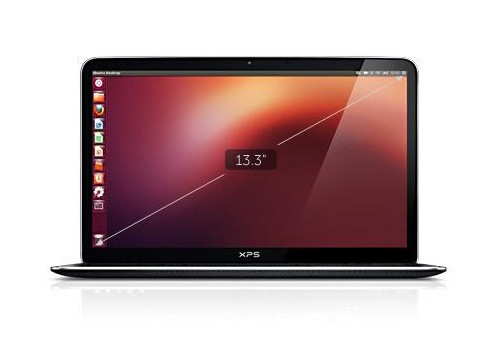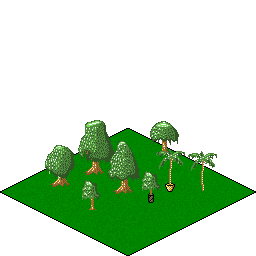Waiting at the lights, my bag popped off the back of my bike somehow. I noticed straight away because the weight was different, but by the time I’d stopped and turned around, the ute behind me had driven over it with not one, but both sets of wheels.

The guy looked at me briefly, then drove off. I didn’t even think to note his license plate, I was too busy freaking out on the traffic island. My laptop is seriously my most important possession and it was immediately obvious it’s been completely written off.
I checked out my insurance, but it’s only for medical and third party which means I’ve got nothin’. I can shift some money around, but it’s certainly changed my short-term plans.
So I set out on a search for a new computer. I wasn’t going to buy another Samsung Series 9 because the quality of the screen was absolutely rubbish and having used it for a month or so I couldn’t justify the price again. So I went searching, and found the Dell XPS 13.

Not the Developer Edition
I was originally looking at the Ubuntu Developer Edition which isn’t available in Australia. The Developer Edition comes with Ubuntu pre-installed, and a bunch of compatibility patches and developer tools already loaded on.
It’s a pretty attractive deal, because Dell have been contributing their modifications back to the Linux kernel to make sure this machine is the Linux latop amongst the Windows-crippled alternatives out there.
The XPS 13 is the same machine, just with Windows pre-installed instead. All the same bits and pieces under the hood (and a few extra stickers), but you can wipe Windows and install your choice of Linux distro over the top with no problems at all.
The Specs
There are a few models of this machine available, and I can’t find mine on the Dell site any more, so your mileage may vary.
- Size
- 13.3″
- CPU
- Intel i5/i7 available
- RAM
- 8GB Dual channel DDR3 1600Mhz
- Storage
- 128 GB SSD (Mine has 256 GB, but this no longer seems to be an option.)
- Graphics
- Intel® HD Graphics 4000
- Display
- Full 1080p (IPS?) display
- Networking
- Intel Centrino Advanced-N 6235 and Bluetooth 4.0
- Battery
- 47 WHr 6-Cell Battery
- Chassis
- 13″, machined aluminium & carbon fibre composite shell, silicone palm rest
Initial Thoughts
My initial thoughts on this laptop were really positive. This laptop feels expensive.

The device has a full 13.3″ screen, but the size of the laptop is tiny owing to the really small bezel around it. The chassis is an attractive complement of machined aluminium on the lid, carbon fibre on the base, and a silicone finish on the palmrests which is surprisingly nice to use.
There’s a metallic cover on the bottom of the laptop which opens to reveal the Windows and Intel stickers as well as FCC information and other important bits.
There are two USB3 ports, one on the left and one on the right. There’s also a Mini DisplayPort and a headphone jack. There are no other ports on the laptop. If you want to use something like cabled Ethernet you’re going to have to pick up a USB adaptor online ($10 ought to do it on eBay), or if you need more devices you’ll have to look into a USB3 hub.
I’ve noticed the lid can be a little tricky to open as the weight isn’t quite balanced with the opening mechanism but on the flip side, the lid is fixed in place wherever you put it. There’s no wobble or anything because of the heavily weighted hinge.
Installing Linux on the XPS 13
There’s a few ways you can install Linux, by USB flash drive or via an external DVD drive, it’s pretty straightforward.

While the device comes with Microsoft’s “Secure Boot” enabled, you have the option of going into the menus and turning it off. In addition, a number of Linux distros come with Microsoft signed keys that will run with Secure Boot enabled anyway.
Another nice touch is the ability to fall back to BIOS emulation mode, which lets you boot older OSes of if you run into shoddy UEFI support in your distro of choice.
You can get into the UEFI/BIOS interface by pressing F2 on boot. (Keep pressing it until it tells you it’s got it.)
Other than Secure Boot, this is a really straightforward machine to install on. You’ll have no problems.
The Keyboard
The keyboard is really quite nice. It’s backlit, and the chiclet style keys have a fair bit of give to them.
It’s quite nice to type with, much nicer than the Samsung Series 9 for instance, although they’re a bit softer than the generally quite firm MacBook Pro.
I’ve also been told the keyboard is an unusual layout (although I haven’t noticed), but either way you’ll likely get used to it in no time.
The Screen
The screen is the total show stealer. The original XPS 13 had a measly 768p screen, whereas this one has the full 1080p and it’s gorgeous.
I’ve gone through a few screens lately, and this is easily the best one I’ve ever used. It’s easily better than my 2010 era MacBook Pro, and wipes the floor with the rubbish used in most Windows laptops on the market these days, including the Series 9.
The screen is perfectly clear, offers no motion artefacts or screen-door effect at all (unlike it’s shonky bigger brother).
I suspect it’s an IPS screen although I haven’t been able to verify this information anywhere other than one or two news and blog sites. It has perfect colour reproduction, with no vertical colour distortion whatsoever and perfect viewing angles from all directions.
In terms of brightness it’s a 350 nit panel, which is pretty damn good. You can find other brighter laptops on the market, but this one’s perfectly good for indoor and outdoor use. It’s a glossy screen as opposed to a matte, which means it can be impossibly glarey in the wrong environments but I’ve never found myself unable to use the laptop due to lighting conditions.
Whether you’re a designer or developer, you should absolutely consider this laptop for the screen alone.
Trackpad
The trackpad is really nice. It has a smooth finish and tracks well with one or two fingers. It’s gesture capable, although I haven’t used any of these features.
Dell and Canonical have apparently taken the existing Cypress trackpad driver and extended it to support the Developer edition perfectly. These changes have been merged upstream into the proper Linux kernel and should be available on most new distributions.
I’m using the drivers that Fedora 18 picked up, and I’m not sure whether they’re the right ones or not. I’ve noticed very occasionally that the trackpad can get a little jumpy and I’ll need to suspend/resume to reset it. I’m interested in whether people have this issue in newer kernels than version 3.9.4-200.
Noise
This machine actually has a little more noise than I’m used to. While it’s no rocketship like my previous MacBook, it can get somewhat loud under load.
I’ve also noticed that the fan makes funny noises even when not under load. It’s barely noticeable, but if you shove your ear up to the bottom of the laptop you can hear it ticking and scraping. It’s a little bit of a concern, I’m not sure if I need to open it up and clean it or if that would make it worse.
External Monitors/VGA Out
This laptop uses Mini DisplayPort, like older MacBooks, which is pretty well supported.
The laptop itself doesn’t come with any cables, but you can grab a Mini DisplayPort cable to output to DisplayPort, DVI, HDMI or VGA.
I’ve driven my Dell U2711 27″ screen at 2560×1440 over DisplayPort with no problems. I understand there may be difficulties converting from DisplayPort to dual-link DVI etc for very large resolutions, so it pays to use DisplayPort→DisplayPort whenever you can.
I’ve also had problems connecting the Mini DisplayPort to a VGA projector using an Apple dongle. Turns out the Apple dongles are a bit special and won’t work with this particular laptop, so if you’re going to be presenting anywhere you’ll need to bring your own non-Apple adaptor.
Other features
The battery is a 47 WHr 6-Cell Battery but I can’t tell you much more than that. It’s not as good as the Samsung Series 9 for instance, but I rarely find it fails me when I’m out and about through the day. You should check out some other reviews for information on the battery life.
Graphics are standard Intel HD Graphics 4000, which are pretty standard across the board. The benefit of Intel graphics is that everything in Linux is supported so much nicer than with nVidia or ATI. If you’re looking for gaming, it’s not the worst you could do, but you should check around to see how the HD 4000 graphics fare on various games.
Sound is quite good. It’s much better than the Series 9 or 2010 MacBook Pro for instance. I’m not sure where it comes from, but it seems beefier than your average laptop sound. I haven’t put it through any vigorous tests (because it’s laptop sound after all) but I quite like it.
Output from the headphone jack is generally good too, free of pops and hisses, and I haven’t heard any processor squeal come through my earbuds which can be a problem on cheaper systems.
Conclusions
The Dell XPS 13 (Non-Developer Edition) is an awesome laptop and if you’re a Linux user looking for a quality device you should absolutely get this one.
While there’s a lot of different materials gone into the build, the quality is stellar. It’s a good weight, feels tough, and I consider it an extremely attractive design.

All the useless loose ends have been removed (CD Drive, Ethernet, serial) leaving only the very basics. If you need more you can extend it with USB adaptors. It’s the ultimate minimal experience.
The speed is great, the compatibility is stellar and the display is the killer feature that beats out all the other devices on the market (with the exception, of course, of the retina Macs which aren’t much use in Linux anyway).
Everyone who sees the laptop loves it, and I recommend it for everybody. If you’re not convinced, leave a question in the comments and I’ll see what I can do to answer it. Otherwise, you’re going to love this laptop and should check it out now.








